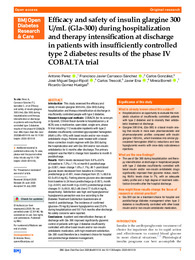Por favor, use este identificador para citar o enlazar este ítem:
https://hdl.handle.net/11000/31203
Efficacy and safety of insulin glargine 300 U/mL (Gla-300) during hospitalization and therapy intensification at discharge in patients with insufficiently controlled type 2 diabetes: results of the phase IV COBALTA trial
Título :
Efficacy and safety of insulin glargine 300 U/mL (Gla-300) during hospitalization and therapy intensification at discharge in patients with insufficiently controlled type 2 diabetes: results of the phase IV COBALTA trial |
Autor :
Perez, Antonio
Carrasco-Sánchez, Francisco Javier 
González, Carlos
Seguí-Ripoll, José Miguel 
Trescolí, Carlos
Ena, Javier 
Borrell, Mireia 
Gomez Huelgas, Ricardo  |
Editor :
BMJ |
Departamento:
Departamentos de la UMH::Medicina Clínica |
Fecha de publicación:
2020-07-18 |
URI :
https://hdl.handle.net/11000/31203 |
Resumen :
Introduction: This study assessed the efficacy and safety of insulin glargine 300 U/mL (Gla-300) during hospitalization and therapy intensification at discharge in insufficiently controlled people with type 2 diabetes.
Research design and methods: COBALTA (for its acronym in Spanish, COntrol Basal durante la hospitalizacion y al ALTA) was a multicenter, open-label, single-arm, phase IV trial including 112 evaluable inpatients with type 2 diabetes insufficiently controlled (glycosylated hemoglobin (HbA1c) 8%-10%) with basal insulin and/or non-insulin antidiabetic drugs. Patients were treated with a basal-bolus-correction insulin regimen with Gla-300 during the hospitalization and with Gla-300 and/or non-insulin antidiabetics for 6 months after discharge. The primary endpoint was the HbA1c change from baseline to month 6 postdischarge.
Results: HbA1c levels decreased from 8.8%±0.6% at baseline to 7.2%±1.1% at month 6 postdischarge (p<0.001, mean change 1.6%±1.1%). All 7-point blood glucose levels decreased from baseline to 24 hours predischarge (p≤0.001, mean changes from 25.1±66.6 to 63.0±85.4 mg/dL). Fasting plasma glucose also decreased from baseline to 24 hours predischarge (p<0.001), month 3 (p<0.001) and month 6 (p<0.001) postdischarge (mean changes 51.5±90.9, 68.2±96.0 and 77.6±86.4 mg/dL, respectively). Satisfaction was high and hyperglycemia/hypoglycemia perception was low according to the Diabetes Treatment Satisfaction Questionnaire at month 6 postdischarge. The incidence of confirmed (glucose<70 mg/dL)/severe hypoglycemia was 25.0% during hospitalization and 59.1% 6 months after discharge. No safety concerns were reported.
Conclusions: Inpatient and intensification therapy at discharge with Gla-300 improved significantly glycemic control of patients with type 2 diabetes insufficiently controlled with other basal insulin and/or non-insulin antidiabetic medication, with high treatment satisfaction. Gla-300 could therefore be a treatment choice for hospital and postdischarge diabetes management.
|
Palabras clave/Materias:
blood Glucose
diabetes mellitus
hypoglycemia
hypoglycemia
type 2 |
Tipo documento :
application/pdf |
Derechos de acceso:
info:eu-repo/semantics/openAccess |
DOI :
https://doi.org/10.1136/bmjdrc-2020-001518 |
Aparece en las colecciones:
Artículos Medicina Clínica
|
 La licencia se describe como: Atribución-NonComercial-NoDerivada 4.0 Internacional.
La licencia se describe como: Atribución-NonComercial-NoDerivada 4.0 Internacional.

 La licencia se describe como: Atribución-NonComercial-NoDerivada 4.0 Internacional.
La licencia se describe como: Atribución-NonComercial-NoDerivada 4.0 Internacional.
.png)